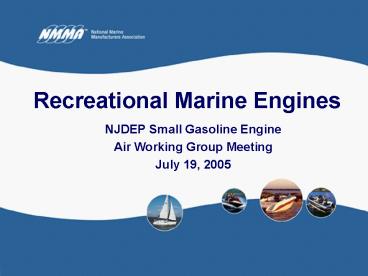Recreational Marine Engines PowerPoint PPT Presentation
1 / 14
Title: Recreational Marine Engines
1
Recreational Marine Engines
NJDEP Small Gasoline Engine Air Working Group
Meeting July 19, 2005
2
- Spark Ignited Engines
- Outboards
- PWC
- SD/I
- marine generators
3
Current Standards
- EPA Stds for OB/PWC, generators
- CA Stds for OB/PWC, generators, SD/I
4
EPA Rulemaking Plans
- Scope
- exhaust and evaporative emissions
- all gasoline powered equipment
- Schedule
- proposal by fall 2005
- (will have formal comment period)
- final rule by end of 2006
- Marine Evaporative Emissions
- hose permeation
- Plastic tank permeation
- diurnal breathing losses
www.epa.gov/otaq/marinesi.htm
EPA recently finalized hose and tank permeation
standards for recreational vehicles 15 g/m2/day
hose permeation (23C, E10, gt 90 reduction) 1.5
g/m2/day fuel tank permeation (28C, E10, gt90
reduction) The original proposed marine diurnal
standard called for a 50 reduction
5
Outboards/PWC Technology
- Current products are a mix of old and new
technology - Technologies used to meet 2006 standards
- 2-stroke direct-injection
- 4-stroke (carbureted and fuel-injected)
- Newer technology engines are well
- below EPA 2006 HCNOx standards
6
SD/I Technology
- Current technology mix
- carbureted and fuel-injected engines
- primarily automotive-based four-stroke engines
- Technology options
- catalytic converters
- with closed-loop control
- (Industry/Govt. testing
- at SwRI)
- EGR (exhaust gas recirculation)
- engine calibration
cat
7
(No Transcript)
8
(No Transcript)
9
Generator Technology
- Baseline Technology
- 4-stroke, carbureted, overhead-valve,
liquid-cooled - some use of catalysts
- Further Emission Control
- more use of existing lower emitting technologies
- optimized calibrations and catalysts
- liquid-cooled engines well below existing EPA
standards - recent development of Safe CO series
- apparently fuel injected with catalyst
- meets ARB 07 HCNOx with large CO reductions
10
Evaporative Emissions
- Permeation
- fuel passes through rubber and plastic in fuel
system - primarily fuel tanks and hoses (fuel and vapor)
- Diurnal Breathing Losses
- temperature increases cause vapor
formation/expansion - temperature decreases bring fresh air into tank
- Others
- refueling, running loss, hot soak, spillage
Diurnal, hot soak, and running loss
Refueling and spillage
Permeation through fuel tank and hoses
11
Four Winns 278 VISTA Cruiser, Torch Lake Test
(GFNMCY001G405) Fuel tank(s) capacity Single
plastic belly tank, 85 gallon Canister vendor
DELPHI Capacity 2.5 L In-service date May
24th, 2005
Engine compartment, bulkhead mount
12
(No Transcript)
13
Boat Test Summary 14 Boats Committed (Sorted by
Canister Size) Four Winns 17 Open Bow 24
gallon Delphi 1.0L Four Winns 18 Open Bow 32
gallon Delphi 1.0L Crestliner 18 Open
Boat Delphi 1.0L Crestliner 18 Open
Boat Delphi 1.0L Crestliner 23
Pontoon Delphi 1.0L Crestliner 23
Pontoon Delphi 1.0L Four Winns 19 Open Bow 50
gallon Delphi 1.5L Four Winns 21 Open Bow 50
gallon Delphi 1.5L Four Winns 27 Cruiser 85
gallon Delphi 2.5L Century 26 Sportfisherman 150
gallon Delphi 4.0L Century 26 Off Shore 1 50
gallon Delphi 4.0L Grady White 23 Off Shore 150
gallon Delphi 4.0L Grady White 30 Off Shore (2)
150 gallon (2) Delphi 4.0L Century 29
Sportfisherman 300 gallon (2)Delphi 4.0 L
14
Marine Engine Summary
- EPA is scheduled to propose an OB, PWC, SD/I, and
evaporative emissions rule in Fall 2005. - OB/PWC- all new engines will meet California
3-star emission rating - SD/I- 5 g/kW-hr
- Evaporative emissions
- Plastic Fuel Tanks
- Hoses, Fuel, Fill and Vent
- Diurnal losses
- CARB SD/I catalyst rule will be implemented in
2008. De facto national rule.

